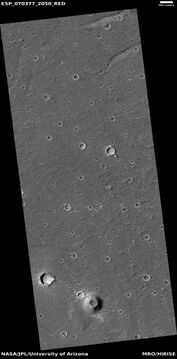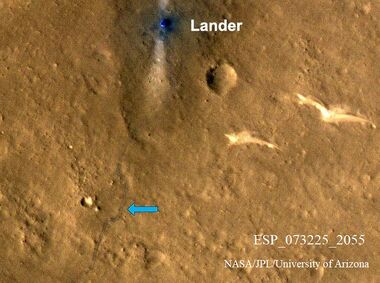Difference between revisions of "Zhurong"
(Is Zhurong dead? Added section on technical innovations.) |
m (→Technical Innovations: grammar) |
||
| Line 17: | Line 17: | ||
==Technical Innovations== | ==Technical Innovations== | ||
| − | Under two circular windows are ten containers which hold N-undecane (a chemical used as sex pheromone by cockroaches and moths), which will melt in the Martian day time, and freeze at night. This chemical has a high heat of fusion, so it will release a fair amount of heat just when the Martian night is getting coldest. It was hoped that this would prolong the life of the Rover by keeping batteries and key electronics warmer at night.<ref>https://twitter.com/CNDeepSpace/status/1478755108074627074</ref> | + | Under two circular windows are ten containers which hold N-undecane (a chemical used as a sex pheromone by cockroaches and moths), which will melt in the Martian day time, and freeze at night. This chemical has a high heat of fusion, so it will release a fair amount of heat just when the Martian night is getting coldest. It was hoped that this would prolong the life of the Rover by keeping batteries and key electronics warmer at night.<ref>https://twitter.com/CNDeepSpace/status/1478755108074627074</ref> |
==End of Mission== | ==End of Mission== | ||
Revision as of 17:21, 27 February 2023
Zhurong is a six-wheeled rover built by China. It landed on Mars in the area called Utopia Planitia on May 14, 2021. Zhurong is about the size of NASA's twin Mars rovers Spirit and Opportunity. It has six scientific instruments, including two panoramic cameras, a ground-penetrating radar and a magnetic field detector. Like America's Curiosity and Perseverance Martian rovers, Zhurong has a laser to zap rocks and thereby study their compositions.[1]
Summary
Research published in May, 2022 described chemical evidence for water discovered by the Zhurong Rover. Hydrated sulfate/silica materials were identified on the Amazonian-age terrain at the landing site. These hydrated minerals were found in bright-toned rocks. Authors of the research interpreted these minerals to be from a "duricrust." The duricrust was formed either by groundwater rising or subsurface ice melting. This duricrust was created just under the surface,and then was uncovered by erosion.
Finding these minerals here suggests that water may have been present at later times then thought. Perhaps liquid water appeared after impacts or from hot magma under the surface. We know there is much ice under the surface and any heat might melt it, and then the water could carry dissolved minerals around. The minerals could then be deposited when water evaporated.[2] [3]
Technical Innovations
Under two circular windows are ten containers which hold N-undecane (a chemical used as a sex pheromone by cockroaches and moths), which will melt in the Martian day time, and freeze at night. This chemical has a high heat of fusion, so it will release a fair amount of heat just when the Martian night is getting coldest. It was hoped that this would prolong the life of the Rover by keeping batteries and key electronics warmer at night.[4]
End of Mission
Solar cells have a short life on Mars (due to dust build up), and as of late February, 2023, the Zhurong rover has been immobile for months. It should have woken up last month. Zhurong had anti dust coatings on its solar cells, but moving dust on Mars builds up static charges which cause them to stick to surfaces strongly. China has not announced the end of the mission, so perhaps the engineers hope that the rover may still recover.[5]
References
- ↑ https://www.space.com/china-mars-rover-landing-success-tianwen-1-zhurong
- ↑ https://www.science.org/doi/10.1126/sciadv.abn8555
- ↑ Liu, Y., et al. 2022. Zhurong reveals recent aqueous activities in Utopia Planitia, Mars. Science Advances. VOL. 8, NO. 19
- ↑ https://twitter.com/CNDeepSpace/status/1478755108074627074
- ↑ https://www.nature.com/articles/d41586-023-00111-3









